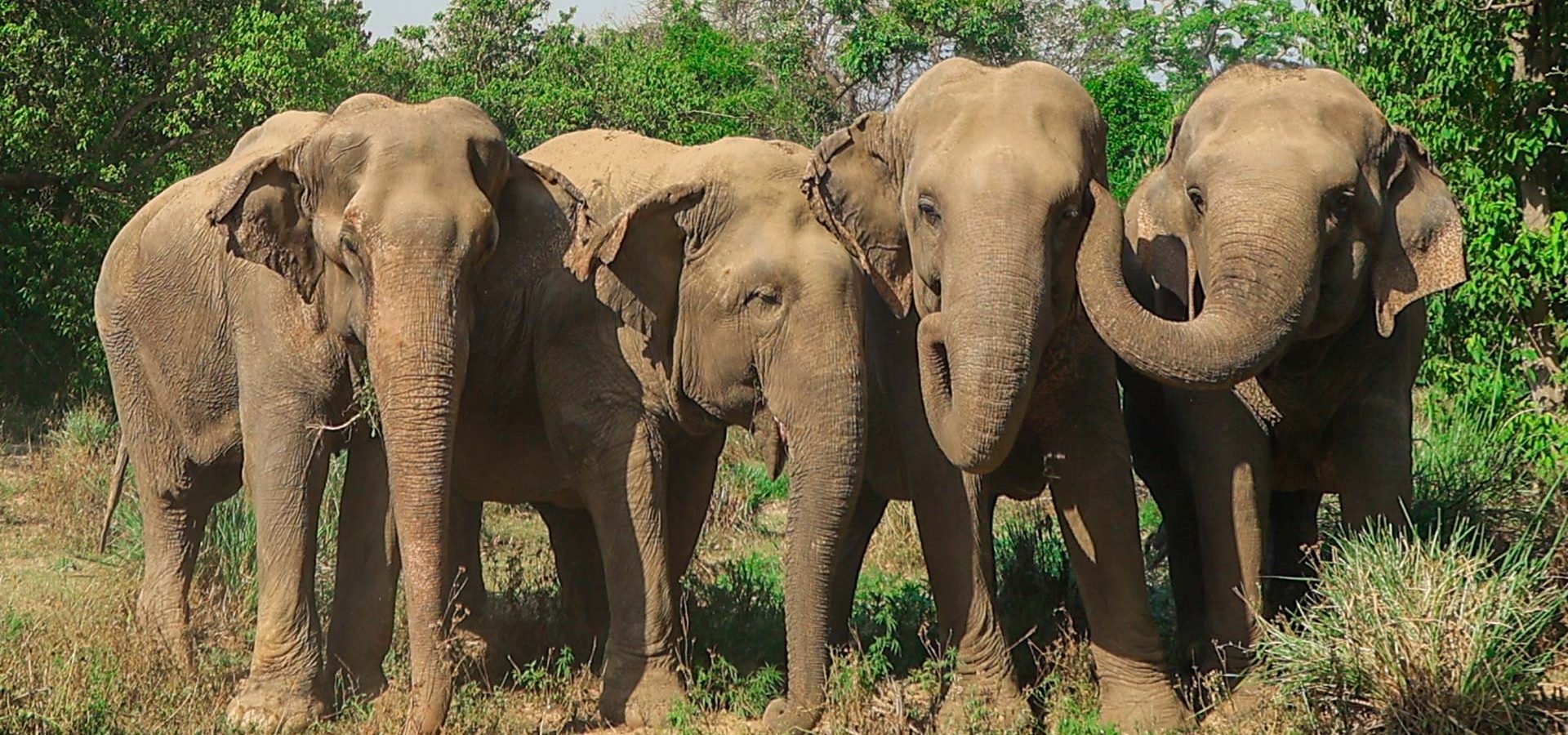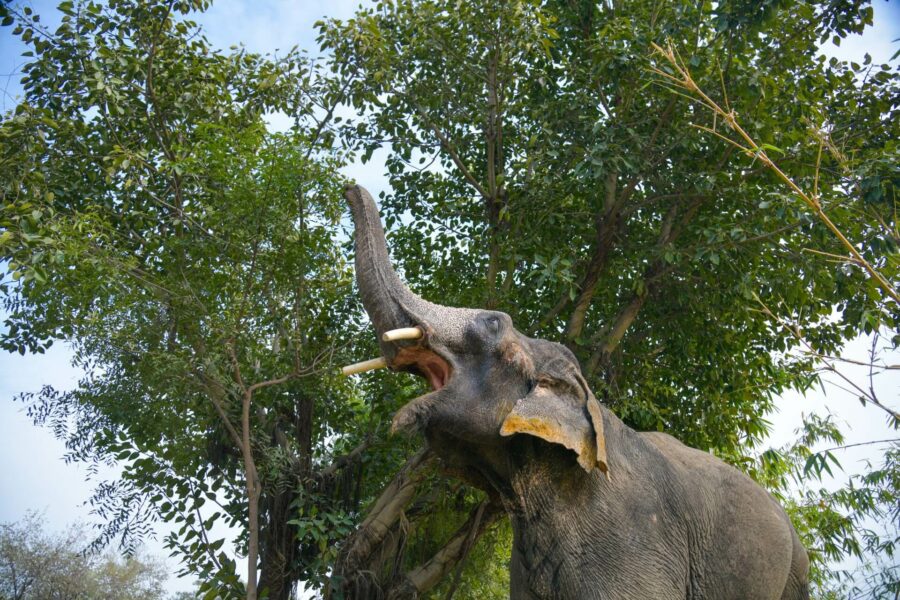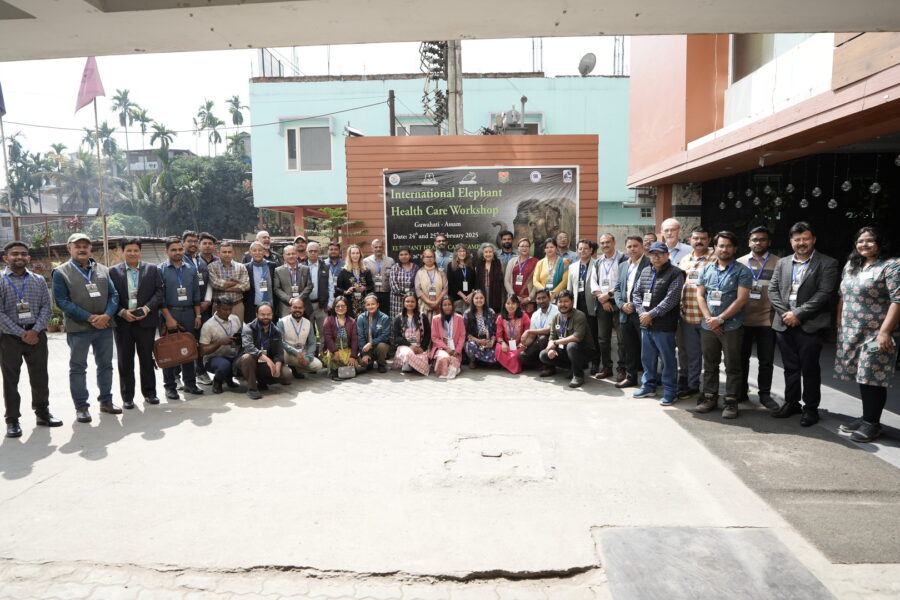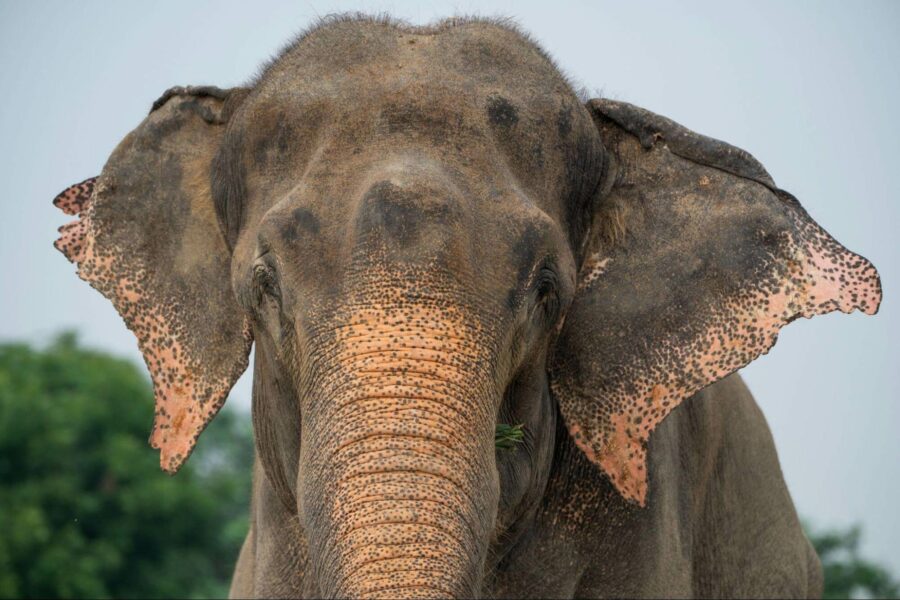It is a well-known fact that wild elephants reside in female-led herds, typically composed of related individuals, such as mothers and their offspring. Female calves remain with the herd, while male calves leave it between the age of 7 and 12 to establish their own territories. Once they depart, young males may either form a small, temporary herd with peers of the same age, or strive for complete independence, depending on the availability of resources. The size of the female herd also depends on the abundance of food in their environment. During periods of scarcity, larger herds may split into smaller herds consisting of closely related individuals. These small herds reunite when resources are plenty.
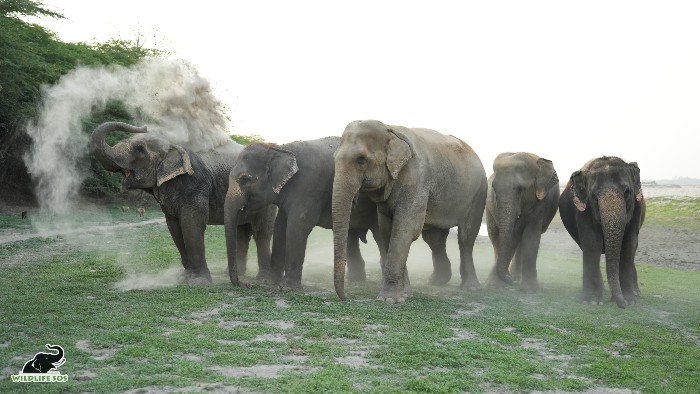
Known for their social intelligence, elephants employ various communication methods and maintain a distinct hierarchical social structure within the herd, which is crucial for their migrations. The matriarch, typically the oldest or most dominant female, assumes leadership within the group. It has been observed that the female head of African elephants has a stronger control of her cohort than the matriarch of an Asian elephant herd. However, both firmly defend, guide, and, when necessary, even discipline the members of her herd.
Considering this deep-rooted need for a family bond, it is highly unfortunate that elephants in captivity are deprived of a natural social structure that is vital for their well-being. Elephants in private ownership are often employed for wedding processions, tourism, the circus or the begging trade, and are kept in solitary confinement so that they can be trained and managed more conveniently. Research indicates that elephants subjected to social isolation are prone to exhibiting stereotypic behaviours, which include stress-related actions like head-bobbing and heightened aggression.

Many of the elephants we have rescued were poached at a young age to support livelihoods for humans. They were never allowed to explore their wild and inherent social skills since they were kept alone and confined. At the Wildlife SOS elephant centres, we encourage rescued female elephants to engage with compatible counterparts, because such alliances can help fill the social void. This not only boosts their overall welfare, but also promotes the psychological healing of abused elephants. Since we are dealing with highly complex and intelligent mammals, socialisation of elephants requires our team to closely observe each rescued elephant’s moods, preferences, behaviour and temperament before one is introduced to another. The amiable “mini-herds” that have formed at our rescue centres have proved to play a huge role in mitigating mental stress for our pachyderms.
Let’s take you through the methodology of how we at Wildlife SOS initiate social bonds between rescued elephants with careful supervision and great sensitivity.
Fostering Friendships
The process of introducing one elephant to another is a delicate one, requiring a lot of patience and caution. Rushing through it can result in adverse outcomes for the anguished elephants that arrive at our centres. Considering the fact that the elephants under our care often suffer from numerous health issues, it’s crucial to ensure the safety and well-being of all involved in the socialisation process.
When a newly rescued elephant arrives at our centres, they are first kept in quarantine to avoid any transmission of diseases. During this time, we diagnose and treat their health issues on priority, while also keeping track of their behaviour. Understanding elephant behaviour is important to determine which elephant or group they can be gradually introduced to. Pairing two dominant females may result in confrontations, while presenting an assertive female to a docile elephant could lead to bullying.
Once a pairing of potential companions is decided, the two females are first introduced to each other indirectly to minimise risks to both elephants. They are allocated enclosures that are in close proximity, from where they get to interact with each other through trumpets, rumbles, and other vocalisations.
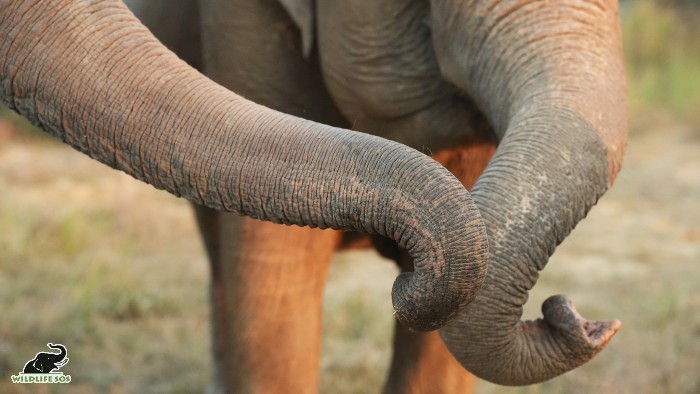
Gentle interactions denote an emotional connection between the elephants, which is a cue for our team to take the next step — a physical introduction, which instead of being forcefully planned, takes place naturally in a neutral setting. The two elephants are taken on the same path during their morning and evening walks at a suitable distance from one another, and are given enough space and time to communicate with each other as well. A positive reaction to each other’s presence, with the continuation of pleasant interactions, are positive signals for our team to house the two in a single, spacious enclosure.
Sometimes, despite our attempts, certain female elephants prefer to be on their own. One such elephant is Priyanka. Though we have attempted to introduce her to other resident elephants, Priyanka has consistently displayed a fondness for solitude. In such situations, we honour the elephant’s choice and provide them with their own field.
During initial introductions, disagreements between pachyderms manifest through loud and aggressive trumpeting, head shaking, and flaring of ears. Incompatible elephants avoid approaching one another by remaining on the opposite sides of their enclosures. Our teams have duly considered both the welcoming and the negative signs exhibited.
Here are some of the remarkable pairs at the Elephant Hospital Campus (EHC) and the Elephant Rehabilitation Centre (ERC) that have shown us how strong, lifelong companionships can steer them through their healing and rehabilitation.
The EHC Herd
Holly and Kalpana
One of the most cited friendships from EHC that perfectly showcases how one rescued elephant can help another is that of Holly and Kalpana’s. For those of you who haven’t watched India’s Jungle Heroes on Nat Geo Wild, you must right away! It gives you the chance to watch the birth of this incredible bond. Though rescued a year apart, the two come from a similar background as illegally owned elephants in the begging trade, where they would be forced to roam the blazing hot streets to collect alms for their owners.
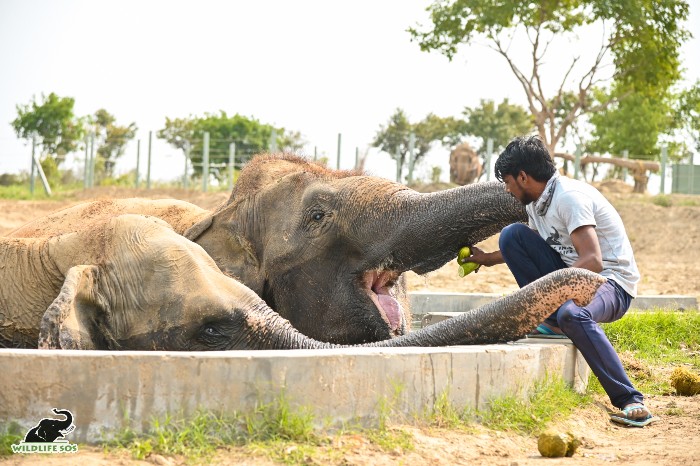
Holly, who is a visually impaired 66-year-old, shares an inseparable link with 53-year-old Kalpana at the elephant hospital. Holly receives specialised geriatric care due to her age, and experiences persistent joint and foot pad issues that make her move slowly. As though conscious of her plight, Kalpana can be seen patiently matching her pace with Holly’s during their daily walks together. If they do drift slightly apart, Holly makes sure to rumble, which serves as a prompt for Kalpana to rush back to her friend. Kalpana even gives Holly company during her treatment sessions by standing right beside her, allowing Holly to lean on her if and when she needs to. The two often relax in their hydrotherapy pool together, where the buoyancy of the water eases the strain on Holly’s joints, and the joyful presence of Kalpana keeps her cheered up!
Arya and Zara
Another loving duo is Arya and Zara, with both elephants rescued in the same year from similar circumstances in the begging trade. Despite the age gap between the two — Arya is 50 years old, while Zara is among the youngest residents of EHC at 23 —their friendship is unwavering! Arya is a blind elephant, and Zara suffers from severely ankylosed ankles. The two consciously match their slow and steady pace with each other’s during their short walks, with Zara also assuming the role of being Arya’s guide. Interestingly, if Zara makes any concerning sound, it is Arya who quickly reaches her side! She extends her trunk to check and make sure that Zara is okay. Also, Arya’s trust in Zara is so complete that even her veterinarians can confidently conduct treatments for her in the presence of her friend.
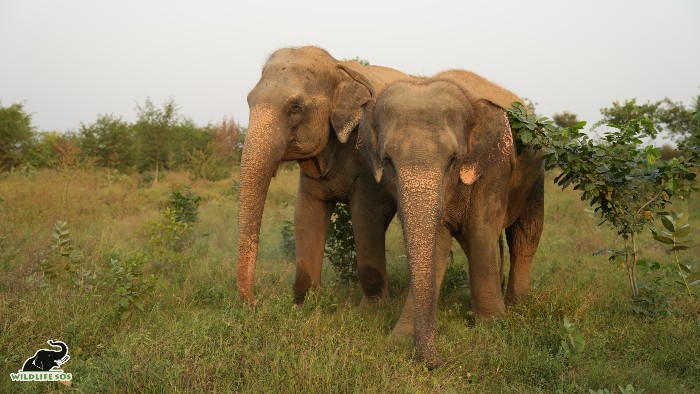
Peanut and Coconut
Two elephants came to our centre as an already bonded pair. Peanut and Coconut are from the ‘Nut Herd’ that was rescued from a circus unit. Lively Peanut and bubbly Coconut, aged 13 and 23 respectively, are among our most mischievous and energetic pachyderms at EHC. They are quick to rip apart each of their enrichments, keeping caregivers on their toes to recreate new and sturdier ones for the duo. When in the pool, the frisky friends splash the water all around, and once outside of it, they make sure to shower together with dust! What astounds us is that if one calls out to the other from across their shared enclosure, the response is immediate! The elephant called upon hurries to reach the other. While their old, yet growing bond keeps them active and engaged, it has also presented a one-of-a-kind challenge: Coco tends to eat faster than Peanut, and after gobbling her share, she takes her trunk to dig into Peanut’s food too! To ensure that both elephants receive an appropriate amount of food, their caregivers now make sure they receive their fodder at a suitable distance from each other.
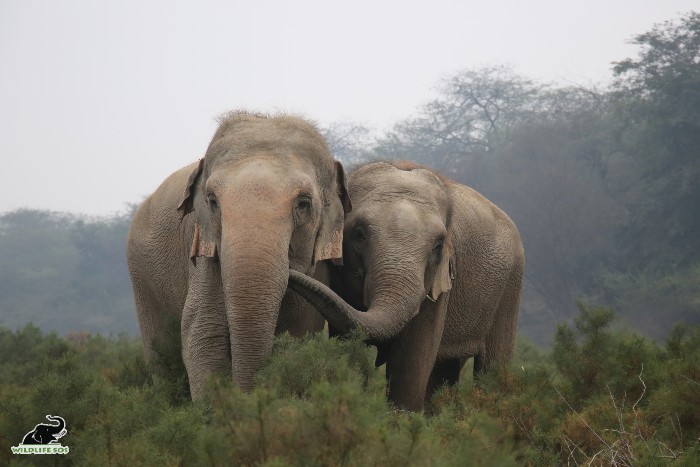
Taj and Tara
A unique friendship at our centre is shared between 19-year-old Taj and 26-year-old Tara, the only duo comprising a male and a female. Taj and Tara were exploited by their separate owners for the purpose of begging, and were brought to Wildlife SOS for temporary care. Their stay soon became permanent, as they were in need of special medical attention to heal from the severe malnutrition and emaciation they were suffering from.
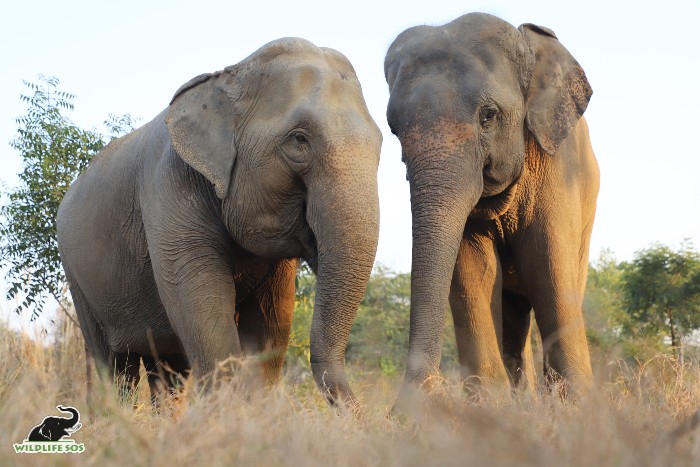
Taj, being the spirited one of the two, would show his discomfort when Tara would be taken for her medical treatments. He would stop eating and would even bang his mighty trunk on the ground! Understanding how the pair finds a sense of security in each other’s presence, our team made sure that Taj and Tara remained close to each other during their respective treatments.
Lakshmi and Pari
So close, yet apart. This twist to the tale took place recently for Lakshmi and Pari at EHC.
Both elephants were rescued from situations of distress in 2021, and were found with numerous debilitating wounds. Lakshmi came to our centre with a worrisome gait and the moniker of ‘Indias’ skinniest elephant’, battling severe starvation and abuse. Pari arrived with ankylosis in her limbs, along with necrosis and abscesses on her toenails and body. While both were on a parallel journey of trying to gain health, a surprising friendship sprung between the two.
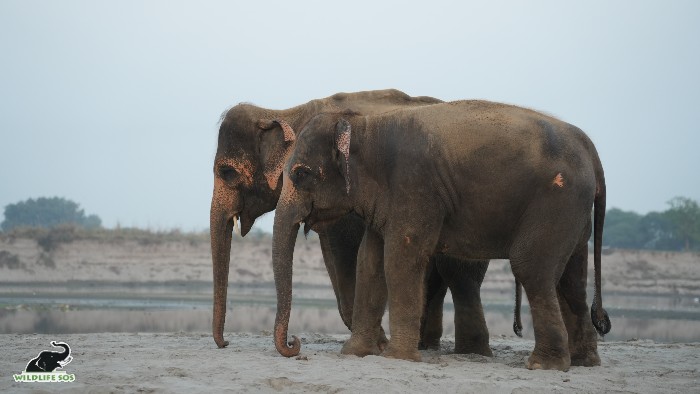
Given that the timings of their walks coincided, the two managed to greet each other with heartwarming gestures daily. They would exchange trumpets while crossing each other’s enclosures as well! Noticing this, the two were given a chance to reside together, till a certain significant challenge cropped up. Lakshmi’s physical condition restricts her from following a regular walk schedule, and Pari, noticing her friend not joining her for a stroll, would refuse to head out for one as well. Moreover, Lakshmi, with her frail build, would often lose her balance if Pari came in contact with her, causing unintentional injuries. With a heavy heart, we came to a tough decision to separate the two till Lakshmi’s health improved to make socialising with Pari safe for her. For now, the two friends are in separate enclosures that face each other, so that they can continue to engage in vocal communication. Lakshmi always welcomes Pari back from her walks with loud trumpets, to which Pari unfailingly responds.
The ERC Herd
Ella, Erika, Lilly and Jasmine
The four resident elephants at the Elephant Rehabilitation Centre (ERC) in Ban Santour, Haryana have formed a unique and dynamic herd. Rescued from various locations and times, this quartet shares a common history of trauma from the begging trade, and also happens to include the last captive elephants from Delhi.
Ella and Erika were rescued on the same day in 2013, while Lilly joined the two a year later. These three pachyderms got along well with each other and created a herd at ERC. Despite being the oldest one at 81, Ella follows the leadership of Erika, who, at 62, is the dominant female. Where Erika goes, Ella and Lilly, aged 45, always follow. Having survived years of torture, Ella is extremely protective of Erika, rushing to her side at the slightest sign of discomfort.

In 2019, Jasmine and Daisy arrived at ERC after being saved from separate situations, and found comfort and solace in each other’s presence. Sadly, Daisy passed away in 2023, leaving Jasmine bereft of a loving friend. To help her cope with the loss, Jasmine was gradually introduced to Lily and Erika, whose companionship brought her back to life.
Now, the four pachyderms share a strong bond as they make their way through their daily routines together. ERC is located within a jungle environment, where leopard encounters are frequent. During these encounters, it is that Ella takes a superior stance and protects all in her herd, including her caregivers. At night, the elephants, much like their wild counterparts, take turns keeping guard while the others sleep. Their bond also extends to acts of mutual aid! One time, Ella got stuck in a patch of mud, and Lilly helped to pull her out by wrapping her trunk around Ella’s torso!
Every rescued elephant that arrives at our centres comes with their own disturbing story of neglect and mistreatment. Our goal is to provide them with a safe and serene environment where they can spend the rest of their lives in comfort and happiness. If you would like to support our mission and contribute to the welfare of these elephants, please consider making a donation.

